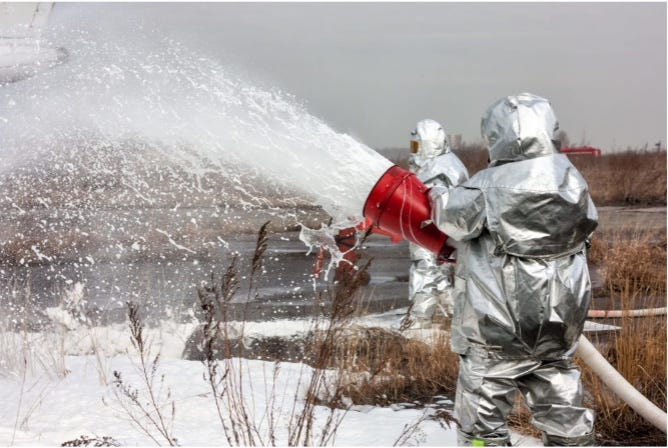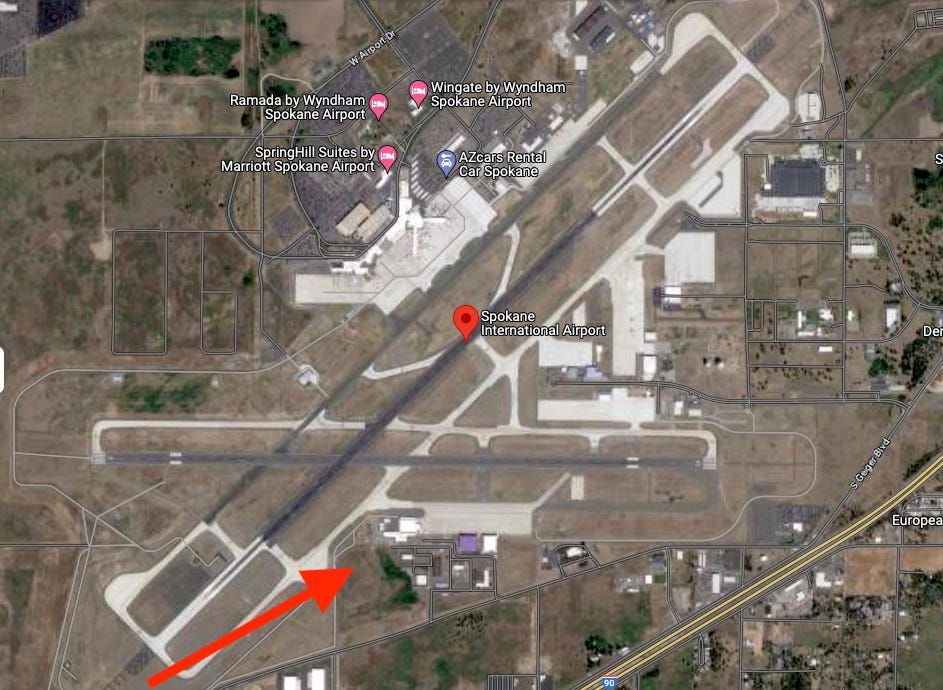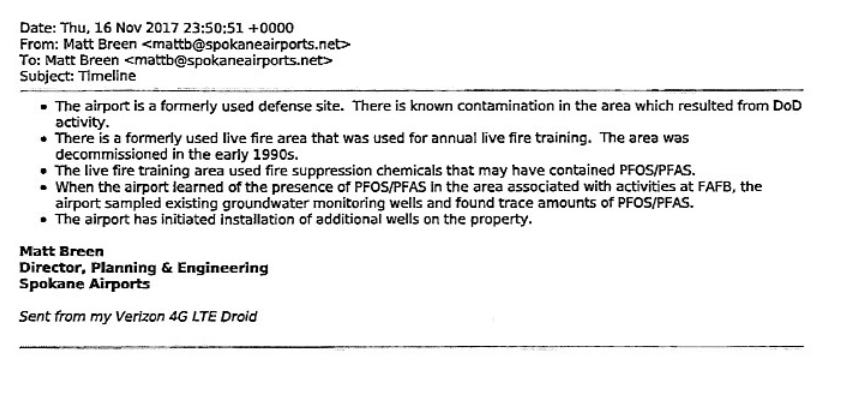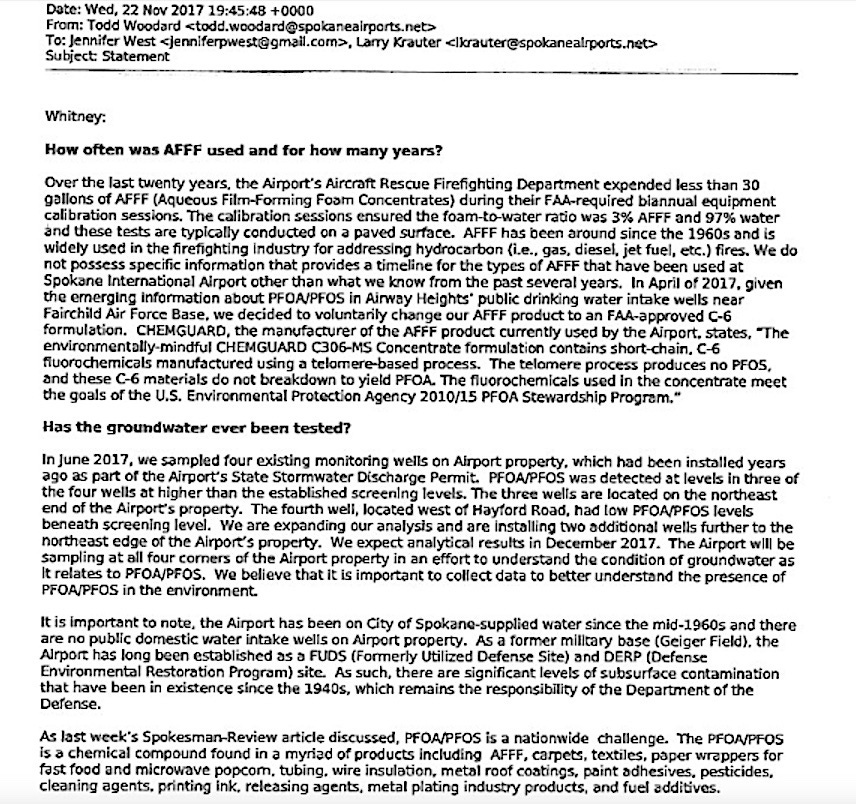Rough Landing
State confronts Spokane International Airport over undisclosed releases of toxic "forever chemicals" to West Plains groundwater. July 8, 2023
Passenger jet above West Plains palisade on approach to Spokane’s International Airport
In a dramatic development in the West Plains groundwater pollution saga, the state Department Ecology has informed the leadership of Spokane International Airport and the state attorney general of its intent to list the airport as a “potentially liable person” under Washington’s Model Toxic Control Act (MTCA).
That news was sent this week to SIA CEO Larry Krauter in a July 6th letter from Nicholas Acklam a senior manager in Ecology’s Toxic Cleanup program. Perhaps the most stunning aspect of the four-page letter is the disclosure, by Ecology, that information about the pollution—evidently known to airport officials for over five years—was only made known to Ecology this spring. Moreover, the SIA documents revealing the contaminated monitoring well water came not from SIA but from a concerned West Plains resident working with the nearby Palisades Neighborhood.
Training exercise using AFFF—Aqueous Film Forming Foam—an aviation fire suppressant that is the main source of PFAS contamination in West Plains groundwater.
The Palisades area is just to the north of the airport in an area where several wells have already tested positive for PFAS. PFAS are a large group of fluorinated, synthetic chemicals associated with cancer and a variety of other deleterious health effects. Several private wells in the Deep Creek neighborhood to the northwest of Palisades have also tested positive for PFAS. As part of acknowledging its share of the responsibility for the PFAS contamination of groundwater, the Air Force has begun to provide filtration systems and bottled water to some of the West Plains residents whose water has tested positive for PFAS.
Red arrow indicates general area of the “Swamp Dump” at Spokane International Airport where groundwater monitoring results show elevated levels of PFAS. Groundwater in the area generally flows to the north toward Highway 2 and beyond. One monitoring well sample, from 2019, rendered 5,200 parts per trillion of PFAS. The Washington state action levels for the main PFAS variants are well below 100 parts per trillion.
At least until now, the presumed major source for the PFAS pollution has been Fairchild. The pollution is clearly connected to the use of PFAS-rich, fire-fighting foam (AFFF) used in firefighting and firefighting training both at the Air Force base and, it turns out, at SIA as well. The disclosure by FAFB officials in 2017 that PFAS contamination had been detected in base monitoring wells led, in short order, to the abrupt shut-off of the nearby City of Airway Heights’s water wells. By then, however, at least hundreds of Airway Heights water users had dramatically high levels of PFAS in their bloodstreams from drinking the contaminated water.
One of the signature PFAS variants, PFHxS, is known to be associated with firefighting foams used both at Fairchild and Spokane International. It was detected at alarmingly high levels in blood sampling of Airway Heights residents conducted by the federal Agency for Toxic Substance and Disease Registry in 2019. The extent to which Spokane International pollution May have contributed to the high exposures in Airway Heights is not yet clear.
Table showing dramatically elevated PFAS variants in blood of Airway Heights water users from 2019. Source, ATSDR PFAS Exposure Assessment Findings, Airway Heights, Spokane County, Washington. PFHxS in top line is a known constituent of Aqueous Film Forming Foam (AFFF) used at Fairchild and SIA.
Still, the information made available to Ecology in the past two months was sufficient to confirm “that a release of hazardous substances has occurred” at SIA based on an initial investigation. That investigation led to “credible evidence” in support of a “proposed finding”that SIA is a “potentially liable person” under the state’s toxic waste law. The letter invites SIA’s response and a potential “challenge” to the finding prior to a formal issuance. Under Washington law the airport would be liable for the cleanup of the hazardous contamination if the final finding is issued.
A key paragraph of the letter is on page 2: “Groundwater monitoring events completed between 2017 and 2019 identified perfluorinated chemicals in the vicinity of the eastern property boundary…The 2017 and 2019 reports were submitted to Ecology during 2023.”
Below are two SIA internal memos from 2017. The first dated November 16, 2017 is from Matt Breen the Airport’s Director of Planning and Engineering, and the second, dated November 22, 2017 from Todd Woodard the SIA’s director of marketing and public affairs. On its face, the memo appears to have been shared with CEO Larry Krauter and Jennifer West, a prominent Spokane public relations and crisis communications specialist. The memos were obtained via a recent public records request.
Even prior to Ecology’s letter, SIA was being criticized by some of its neighbors for being slow to respond and take responsibility for reports of PFAS contamination of local groundwater. John Hancock, an organizer and spokesperson for the newly created West Plains Water Coalition, has recently testified before both the County Commission and Spokane City Council. Several of Hancock’s neighbors in Deep Creek have had their wells contaminated with PFAS. Last Monday he urged the Spokane City Council to, among other things: “Investigate the testing and share the facts about PFAS from the Airport.” (Both the Spokane City Council and Spokane County have elected members on the SIA Board of Directors).
Hancock said he learned of the impending release of the letter from Acklam during a previously scheduled “check-in” meeting yesterday at Ecology’s Spokane offices. He says Acklam was at the meeting and briefed him and two other engaged citizens on Ecology’s progress and plans.
I asked Hancock this morning about his reaction to Ecology’s letter and the SIA’s evident reluctance to voluntarily disclose the PFAS contamination found in the airport’s groundwater monitoring wells.
“The airport had other issues in mind rather than the public safety of its neighbors,” he said. “The wheels of airport expansion and commercial expansion in the West Plains were far more interesting to the airport than our safety.”
No doubt Ecology’s letter will be a welcome development for scores of West Plains residents who’ve voiced their concern and displeasure with the slow pace of investigation and remediation. A long-awaited, Ecology funded groundwater study to better define groundwater and contamination pathways on the West Plains is slated to get underway later this month.
—tjc









Thanks for this. May I cross post?